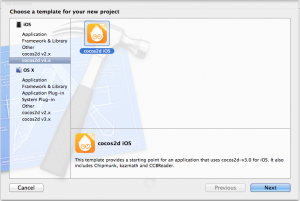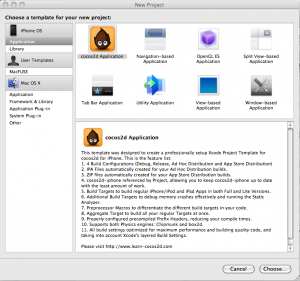A preview version of cocos2d-iphone v3 has been available for a couple days now. I thought I’ll take a closer look and summarize what’s been done, what’s working and what isn’t, what’s new and what’s old but revamped.
Installation
 The installer script has been revamped. It has a different name (install.sh) and different parameters (-force instead of -f).
The installer script has been revamped. It has a different name (install.sh) and different parameters (-force instead of -f).
The first thing I noticed is that the installer is downloading Chipmunk2D. Made me wonder why, so I double-checked to confirm: Chipmunk isn’t included in the archive. This means no offline installation.
I’ll explain later why Chipmunk isn’t included.
Project & File Templates
In the preview there’s only one project template. It doesn’t demo any physics features, it’s your typical “Hello World” example with buttons.
There seems to be an issue with the template where any attempt to save it to a custom location caused Xcode to crash. In fact every time the “Save File” sheet came up and I didn’t click on “Create” right away, Xcode would crash. That’s just one of the reasons why it’s still a preview.
The CCNode File Template isn’t worth mentioning at this point, it creates an empty Objective-C class and is barely different from the regular Objective-C class template at this time.
Hello World v3
Continue reading »
The Cocos2D Installer has been superseded by Kobold2D!
Since you’re looking to install Cocos2D, you may be interested to hear about the Kobold2D game engine. Kobold2D is designed to make Cocos2D developers more productive. Of course it comes with an installer, and includes Cocos2D.
Original Post
With the release of the unstable cocos2d-iphone v1.0.0 rc3 version today I’ve updated the Cocos2D Installer to include this new version, as well as an updated version of Cocos3D (v0.5.4). The installer will install the Xcode templates for you for both cocos2d and cocos3d in both Xcode 3 and Xcode 4 versions.
Download the Cocos2D Installer (66 MB)
The Cocos2D installer includes cocos2d-iphone v0.99.5 (stable) & v1.0.0 rc3 (unstable) and cocos3d v0.5.4.
Cocos2D/Cocos3D will be installed to the user’s Documents folder in appropriately named subfolders. You can move these folders after installation to another folder without breaking anything.
I have updated the unofficial Cocos2D installer to include the cocos2d-iphone-v1.0.0-rc version so that you can use the Xcode 4 templates. I also added Cocos3D so that you don’t have to run its install scripts anymore.
The installer now installs the following folders to your ~/Documents folder:
- cocos2d-iphone-0.99.5 (latest stable)
- cocos2d-iphone-1.0.0-rc (latest unstable)
- cocos3d-0.5.3 (latest beta)
Warning: Project Templates are buggy!
Depending on Cocos2D/3D version and the version of Xcode, you’ll notice that some of the project templates will not compile without manually fixing some compile errors. This has nothing to do with the installer, the same thing happens when you install the templates manually with the .sh scripts.
For example, the project templates for cocos2d-iphone-1.0.0-rc do not work in Xcode 3 - the ones for Xcode 4 work fine. The Cocos3D project template does not work out of the box in Xcode 4, you have to manually copy and add the Cocos3D files (refer to the readme for more info). The version for Xcode 3 works fine.
Based on the Xcode version you currently use for developing new Cocos2D projects:
- Xcode 3: use the Cocos2D v0.99.5 and Cocos3D Project Templates to start new projects. You can manually update to Cocos2D v1.0.0 afterwards.
- Xcode 4: you will have to start with Cocos2D v1.0.0 (rc). If you want to develop Cocos3D applications, refer to the readme to learn the manual steps involved in creating a working Cocos3D project.
You can get Kobold2D from www.kobold2d.com which is an easy to use wrapper (and installer) for cocos2d and related libraries plus many example projects. If you want to support development of the new, modernized version of Kobold2D then please consider joining KoboldTouch.
Installing Cocos2D Xcode Templates
If all you want to do is to install one of the latest cocos2d version’s Xcode templates, type this in a Terminal window:
First, change to the cocos2d-iphone directory using the cd command, for example if you unpacked cocos2d to ~/Documents the command would be:
|
1 |
cd ~/Documents/cocos2d-iphone-2.0 |
Then run the Xcode templates installer script, -f forces overwrite of any existing cocos2d templates:
|
1 |
./install-templates.sh -f |
You can find more details in my blog post about enabling ARC in a cocos2d project.
If you’re new to cocos2d or Objective-C programming, make sure you enable ARC in all your projects! Not using ARC will be a painful experience, it makes it harder to write correct Objective-C code, it will slow you down, it might even demotivate you. Use nothing but ARC. Please. I still see way too many cocos2d related questions on stackoverflow.com which would not be an issue if the users had simply enabled ARC.













